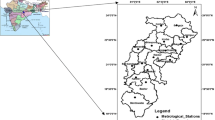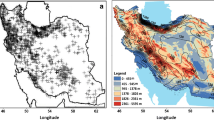Abstract
Increasing global temperatures during the last century have had their own effects on other climatic conditions, particularly on precipitation characteristics. This study was meant to investigate the spatial and temporal monthly trends of precipitation using the least square error (LSE) approach for the northwest of Iran (NWI). To this end, a database was obtained from 250 measuring stations uniformly scattered all over NWI from 1961 to 2010. The spatial average of annual precipitation in NWI during the period of study was approximately 220.9–726.7 mm. The annual precipitation decreased from southwest to northeast, while the large amount of precipitation was concentrated in the south-west and in the mountainous areas. All over NWI, the maximum and minimum precipitation records occurred from March to May and July to September, respectively. The coefficient of variation (CV) is greater than 44 % in all of NWI and may reach over 76 % in many places. The greatest range of CV, for instance, occurred during July. The spatial variability of precipitation was consistent with a tempo-spatial pattern of precipitation trends. There was a considerable difference between the amounts of change during the months, and the negative trends were mainly attributed to areas concentrated in eastern and southern parts of NWI far from the western mountain ranges. Moreover, limited areas with positive precipitation trends can be found in very small and isolated regions. This is observable particularly in the eastern half of NWI, which is mostly located far from Westerlies. On the other hand, seasonal precipitation trends indicated a slight decrease during winter and spring and a slight increase during summer and autumn. Consequently, there were major changes in average precipitation that occurred negatively in the area under study during the observation period. This finding is in agreement with those findings by recent studies which revealed a decreasing trend of around 2 mm/year over NWI during 1966–2005.




Similar content being viewed by others
References
Alexandersson H (1986) A homogeneity test applied to precipitation data. J Clim 6 (6):661–675
Alijani B (1996) Climate of Iran. Payam Noor University Press, Iran
Asakereh H (2007) Tempo spatial changes of Iran precipitation during recent decades. Geogr Dev Iran J 10:145–164
Asakereh H (2011) An analysis of precipitation regime change in Zanjan province. Nivar, Iran Meteorol Org J 71:63–76
Asakereh H, Razmi R (2011) Climatology of precipitation in north west of Iran. Geogr Dev Iran J 25:137–158
Asakereh H, Razmi R (2012) Analysis of annual precipitation changes in northwest of Iran. Geogr Environ Plan J Iran J 47:147–162
Asakereh H, Razmi R (2014) Temporal distribution and regime of precipitation of northwest of Iran. Geogr Res Iran J 112:145–160
Asakereh H, Syfipour Z (2013) Spatial modeling of annual precipitation of Iran. Geogr Dev Iran J 29:15–30
Barry RG, Chorley RJ (1998) Atmosphere, weather and climate. Routledge, UK
Bodri L, Cermak V, Kresl M (2005) Trends in precipitation variability: Prague (the Czech Republic). Clim Chang 72:151–170
Bradley R, Diaz H, Eischeid J, Jones D, Kelly P, Goodess C (1987) Precipitation fluctuations over northern hemisphere land areas since the mid-nineteenth century. Science 237:171–175
Buishand TA (1982) Some methods for testing the homogeneity of rainfall records. J Hydrol 58 (1-2):11–27
Deutsch CV, Journel AG (1998) Geostatistical SofONare library and User’s guide. Oxford University Press, UK
Feidas H, Noulopoulou C, Makrogiannis T, Bora-Senta E (2007) Trend analysis of precipitation time series in Greece and their relationship with circulation using surface and satellite data: 1955–2001. Theor Appl Climatol 87:155–177
González-Rouco FJ, Jiménez JL, Quesada V, Valero F (2001) Quality Control and Homogeneity of Precipitation Data in the Southwest of Europe. J Clim 14 (5):964–978
Hamidianpoor M, Alijani B, Sadeghi A (2010) Identifying the synoptic patterns of heavy precipitations in north east of Iran. J Arid Reg Geogr study Iran J 1:1–16
Huth R (1999) Testing for trends in data unevenly distributed in time. Theor Appl Climatol 64:151–162
Jacobeit J, Jonsson P, Barring L, Beck C, Ekstrom M (2001) Zonal indices for Europe 1780–1995 and running correlations with temperature. Clim Chang 48:219–241
Jacobeit J, Rathmann J, Philipp A, Jones P (2009) Central European precipitation and temperature extremes in relation to large-scale atmospheric circulation types. Meteorol Mag 218:397–410
Jacobeit J, Wanner H, Luterbacher J, Beck C, Philipp A, Sturm K (2003) Atmospheric circulation variability in the North-Atlantic-European area since the mid-seventeenth century. Clim Dyn 20:341–352
Jahanbakhsh S, Zolfaghari H (2002) Survey of synoptic pattern of daily precipitation in west of Iran. Geogr Res Iran J 64:234–258
Janbaz Ghobadi GR, Mofidi A, Zarrin A (2011) Recognizing the synoptic patterns of wintertime heavy precipitation in the southern coast of the Caspian Sea. Geogr Environ Plan Iran J 22:23–40
Kadioglu M, Ozturk N, Erdun H, Sen Z (1999) On the precipitation climatology of Turkey by harmonic analysis. Int J Climatol 19:1717–1728
Kariya T, Kurata H (2004) Generalized least squares. John Wiley & Sons Ltd, UK
Karl TR, Knight RW (1997) Secular trends of precipitation amount, frequency, and intensity in the United States. B Am Meteorol Soc 79:231–241
Kottegoda NT, Natale L, Raiteri E (2008) Stochastic modeling of periodicity and trend for multisided daily precipitation simulation. J Hydrol 361:319–329
Kyselý J (2009) Trends in heavy precipitation in the Czech Republic over 1961–2005. Int J Climatol 29:1745–1758
Liebmann B, Marengo J (2001) Inter-annual variability of the rainy season and precipitation in the Brazilian Amazon basin. J Clim 14:4308–4318
Liu D, Guo S, Chen X, Shao Q (2012) Analysis of trends of annual and seasonal precipitation from 1956 to 2000 in Guangdong province, China. Hydrol Sci J 57:358–369
Mallet J-L (2002) Geomodeling. Oxford University Press, UK
Masodian SA (2009) Precipitation regions of Iran. Geogr Dev Iran J 13:79–91
Masodian SA (2011) Climate of Iran. Toos Publication, Iran
Mofidi A (2005) Synoptic climatology of heavy precipitations with Red Sea origin in the Middle East; a review. Geogr Res Iran J 75:71–93
Niu J (2013) Precipitation in the Pearl River basin, South China: scaling, regional patterns, and influence of large-scale climate anomalies. Stoch Env Res Risk 27:1253–1268
Philandras CM, Nastos PT, Kapsomenakis J, Douvis KC, Tselioudis G, Zerefos CS (2011) Long term precipitation trends and variability within the Mediterranean region. Nat Hazard Earth Syst 11:3235–3250
Rahimzadeh F, Asgari A, Fattahi E (2009) Variability of extreme temperature and precipitation in Iran during recent decades. Int J Climatol 29:329–343
Rao C, Radhakrishna TH, Heumann SC (2008) Linear models and generalizations least squares and alternatives. Heidelberg, USA
Rawlings JO, Pantula SG, Dickey DA (1998) Applied regression analysis: a research tool. Springer-Verlag, USA
Razi T, Azizi G (2007) Zoning precipitation regime of West Iran by using principal component analyses and clustering. J Water Resourc Iran 8:62–66
Ripley BD (2004) Spatial statistics. John Wiley & Sons, USA
Rodriguez-Puebla C, Encinas AH, Nieto S, Garmendia J (1998) Spatial and temporal patterns of annual precipitation variability over the Iberian Peninsula. Int J Climatol 18:299–316
Sadiq N (2010) Climatic variability and linear trend models for the five major cities of Pakistan. J Geogr Geol 2:83–92
Shi W, Yu X, Liao W, Wang Y, Jia BJ (2013) Spatial and temporal variability of daily precipitation concentration in the Lancang River basin, China. J Hydrol 495:197–207
Singh VP (1997) Effect of spatial and temporal variability in precipitation and watershed characteristics on stream flow hydrograph. Hydrol Process 11:1649–1669
Slonosky V, Jones P, Davies T (2000) Variability of the surface atmospheric circulation over Europe, 1774–1995. Int J Climatol 20:1875–1897
Trigo IF, Bigg GR, Davies TD (2002) Climatology of cyclogenesis mechanisms in the Mediterranean. Mon Weather Rev 130:549–569
Trigo IF, Davies TD, Bigg GR (1999) Objective climatology of cyclones in the Mediterranean region. J Clim 12:1685–1696
Wang H, Chen Y, Chen Z (2013) Spatial distribution and temporal trends of mean precipitation and extremes in the arid region, northwest of China, during 1960-2010. Hydrol Process 27:1807–1818
Wei F, Xie Y, Mann ME (2008) Probabilistic trend of anomalous summer precipitation in Beijing: role of inter-decadal variability. J Geophys Res 113:D20106. doi:10.1029/2008JD010111
Weisberg S (2005) Applied linear regression. A John Wiley & Sons, USA
Wilks DS (2006) Statistical methods in the atmospheric science. Elsevier Inc, USA
Xu Z, Takeuchi K, Ishidaira H (2003) Monotonic trend and step changes in Japanese precipitation. J Hydrol 279:144–150
Zhang X, Vincent LA, Hogg WD, Niitsoo A (2010) Temperature and precipitation trends in Canada during the twentieth century. Atmos Ocean 38:395–429
Zhang Q, Xu CY, Zhang Z, Chen YD, Cl L, Lin H (2008) Spatial and temporal variability of precipitation maxima during 1960–2005 in the Yangtze River basin and possible association with large-scale circulation. J Hydrol 353:215–227
Acknowledgment
I would like to thank Islamic republic of Iran Meteorological Organization (IRIMO) and Ministry of Power for providing me with the data. If it were not for their cooperation, this study would have not been possible.
Author information
Authors and Affiliations
Corresponding author
Rights and permissions
About this article
Cite this article
Asakereh, H. Trends in monthly precipitation over the northwest of Iran (NWI). Theor Appl Climatol 130, 443–451 (2017). https://doi.org/10.1007/s00704-016-1893-8
Received:
Accepted:
Published:
Issue Date:
DOI: https://doi.org/10.1007/s00704-016-1893-8




